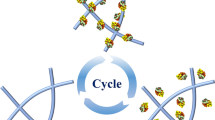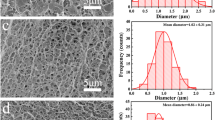Abstract
Hydrophobic interaction chromatography (HIC) as an indispensable method for protein purification has attracted considerable attentions of researchers as well as biopharmaceutical industries. However, the low binding capacity and slow adsorption rate of the currently available HIC media lead to a little supply and high price of the highly purified proteins. Herein, nanofibrous membranes with hydrophobic binding sites were developed for HIC by directly coupling phenyl glycidyl ether on the hydrolyzed cellulose acetate nanofiber membrane (cellulose-phenyl NFM). Scanning electron microscope (SEM), water contact angle (WCA), Fourier transform infrared (FTIR), thermogravimetric analysis (TGA), Brunauer–Emmett–Teller (BET) surface area analysis and capillary flow porometer (CFP) were applied to evaluate the physically and chemically structural transformation. The obtained cellulose-phenyl NFMs showed a proper hydrophilcity (WCA = 37°), a relatively high BET surface area (3.6 times the surface area of commercial fibrous membranes), and tortuous-channel structure with through-hole size in the range of 0.25–1.2 μm, which led to a little non-specificity adsorption, high bovine serum albumin adsorption capacity of 118 mg g−1, fast adsorption process within 12 h, good long-term stability and reusability. Moreover, compared with traditional modification methods which always include activation and graft two steps, direct coupling method is more efficient for HIC media fabrication. Therefore, cellulose-phenyl NFMs with outstanding protein adsorption performance could be a kind of promising candidate for HIC.
Graphic Abstract










Similar content being viewed by others
References
Jungbauer A. Chromatographic media for bioseparation. J Chromatogr A. 2005;1065:3.
Chen B, Peng Y, Valeja SG, Xiu L, Alpert AJ, Ge Y. Online hydrophobic interaction chromatography-mass spectrometry for top-down proteomics. Anal Chem. 2016;88:1885.
Kawai T, Saito K, Lee W. Protein binding to polymer brush, based on ion-exchange, hydrophobic, and affinity interactions. J Chromatogr B Anal Technol Biomed Life Sci. 2003;790:131.
Ghosh R. Separation of proteins using hydrophobic interaction membrane chromatography. J Chromatogr A. 2001;923:59.
Chang CS, Suen SY. Modification of porous alumina membranes with n-alkanoic acids and their application in protein adsorption. J Membr Sci. 2006;275:70.
Yu D, Chen X, Pelton R, Ghosh R. Paper-PEG-based membranes for hydrophobic interaction chromatography: purification of monoclonal antibody. Biotechnol Bioeng. 2008;99:1434.
Ghosh R, Wang L. Purification of humanized monoclonal antibody by hydrophobic interaction membrane chromatography. J Chromatogr A. 2006;1107:104.
Ghosh R. Fractionation of human plasma proteins by hydrophobic interaction membrane chromatography. J Membr Sci. 2005;260:112.
Huang R, Mah KZ, Malta M, Kostanski LK, Filipe CDM, Ghosh R. Chromatographic separation of proteins using hydrophobic membrane shielded with an environment-responsive hydrogel. J Membr Sci. 2009;345:177.
Yu D, Ghosh R. Integrated fragmentation of human IgG and purification of fab using a reactant adsorptive membrane bioreactor separator system. Biotechnol Bioeng. 2009;104:152.
Wang L, Ghosh R. Feasibility study for the fractionation of the major human immunoglobulin G subclasses using hydrophobic interaction membrane chromatography. Anal Chem. 2010;82:452.
Yu D, Shang X, Ghosh R. Fractionation of different PEGylated forms of a protein by chromatography using environment-responsive membranes. J Chromatogr A. 2010;1217:5595.
Yoo SM, Ghosh R. Simultaneous removal of leached protein-A and aggregates from monoclonal antibody using hydrophobic interaction membrane chromatography. J Membr Sci. 2012;390:263.
Shang X, Wittbold W, Ghosh R. Purification and analysis of mono-PEGylated HSA by hydrophobic interaction membrane chromatography. J Sep Sci. 2013;36:3673.
Sadavarte R, Spearman M, Okun N, Butler M, Ghosh R. Purification of chimeric heavy chain monoclonal antibody EG2-hFc using hydrophobic interaction membrane chromatography: an alternative to protein-A affinity chromatography. Biotechnol Bioeng. 2014;111:1139.
Mah KZ, Ghosh R. Paper-based composite lyotropic salt-responsive membranes for chromatographic separation of proteins. J Membr Sci. 2010;360:149.
Wu Q, Wang R, Chen X, Ghosh R. Temperature-responsive membrane for hydrophobic interaction based chromatographic separation of proteins in bind-and-elute mode. J Membr Sci. 2014;471:56.
Chiu HT, Lin JM, Cheng TH, Chou SY. Fabrication of electrospun polyacrylonitrile ion-exchange membranes for application in lysozym. Express Polym Lett. 2011;5:308.
Jones TT, Fernandez EJ. Hydrophobic interaction chromatography selectivity changes among three stable proteins: conformation does not play a major role. Biotechnol Bioeng. 2004;87:388.
Kosior A, Antosova M, Faber R, Villain L, Polakovic M. Single-component adsorption of proteins on a cellulose membrane with the phenyl ligand for hydrophobic interaction chromatography. J Membr Sci. 2013;442:216.
Cui FH, Li Y, Zhao X, Yin X, Yu J, Ding B. Multilevel porous structured polyvinylidene fluoride/polyurethane fibrous membranes for ultrahigh waterproof and breathable application. Comput Commun. 2017;6:63.
Ding XX, Li Y, Si Y, Yin X, Yu JY, Ding B. Electrospun polyvinylidene fluoride/SiO2 nanofibrous membranes with enhanced electret property for efficient air filtration. Comput Commun. 2019;13:57.
Hua T, Li Y, Zhao X, Yin X, Yu JY, Ding B. Stable low resistance air filter under high humidity endowed by self-emission far-infrared for effective PM 2.5 capture. Comput Commun. 2017;6:29.
Ma JC, Wang XQ, Fu QX, Si Y, Yu JY, Ding B. Highly carbonylated cellulose nanofibrous membranes utilizing maleic anhydride grafting for efficient lysozyme adsorption. ACS Appl Mater Interfaces. 2015;7:15658.
Zhang LF, Menkhaus TJ, Fong H. Fabrication and bioseparation studies of adsorptive membranes/felts made from electrospun cellulose acetate nanofibers. J Membr Sci. 2008;319:176.
Che AF, Huang XJ, Xu ZK. Polyacrylonitrile-based nanofibrous membrane with glycosylated surface for lectin affinity adsorption. J Membr Sci. 2011;366:272.
Fu QX, Wang XQ, Si Y, Liu LF, Yu JY, Ding B. Scalable fabrication of electrospun nanofibrous membranes functionalized with citric acid for high-performance protein adsorption. ACS Appl Mater Interfaces. 2016;8:11819.
Fu QX, Duan C, Yan ZS, Si Y, Liu LF, Yu JY, Ding B. Electrospun nanofibrous composite materials: a versatile platform for high efficiency protein adsorption and separation. Comput Commun. 2018;8:92.
Ogawa T, Ding B, Sone Y, Shiratori S. Super-hydrophobic surfaces of layer-by-layer structured film-coated electrospun nanofibrous membranes. Nanotechnology. 2007;18:165607.
Dods SR, Hardick O, Stevens B, Bracewell DG. Fabricating electrospun cellulose nanofibre adsorbents for ion-exchange chromatography. J Chromatogr A. 2015;1376:74.
Zhou B, Li Y, Deng HB, Hu Y, Li B. Antibacterial multilayer films fabricated by layer-by-layer immobilizing lysozyme and gold nanoparticles on nanofibers. Colloid Surface B. 2014;116:432.
Arndt P, Bockholt K, Gerdes R, Huschens S, Pyplo J, Redlich H, Samm K. Cellulose oligomers: preparation from cellulose triacetate, chemical transformations and reactions. Cellulose. 2003;10:75.
Singh R, Arora S, Lal K. Thermal and spectral studies on cellulose modified with various cresyldichlorothiophosphates. Thermochim Acta. 1996;289:9.
Chen J, Sun Y. Modeling of the salt effects on hydrophobic adsorption equilibrium of protein. J Chromatogr A. 2003;992:29.
Mak S, Chen D. Fast adsorption of methylene blue on polyacrylic acid-bound iron oxide magnetic nanoparticles. Dyes Pigments. 2004;61:93.
Acknowledgements
This work was supported by the National Natural Science Foundation of China (Grant Nos. 51673037, 51873029, and 81771338), and the Science and Technology Commission of Shanghai Municipality (Grant No. 18511109500).
Author information
Authors and Affiliations
Corresponding authors
Ethics declarations
Conflict of interest
The authors declare no conflicts of interest.
Electronic supplementary material
Below is the link to the electronic supplementary material.
Rights and permissions
About this article
Cite this article
Wang, L., Fu, Q., Yu, J. et al. Cellulose Nanofibrous Membranes Modified with Phenyl Glycidyl Ether for Efficient Adsorption of Bovine Serum Albumin. Adv. Fiber Mater. 1, 188–196 (2019). https://doi.org/10.1007/s42765-019-00010-1
Received:
Accepted:
Published:
Issue Date:
DOI: https://doi.org/10.1007/s42765-019-00010-1




